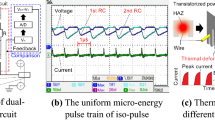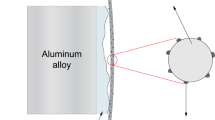Abstract
The third generation of superhard semiconductor materials, represented by single-crystal SiC, is used widely in microelectronics due to their excellent physical and mechanical properties. However, their high hardness and brittleness have become bottlenecks in their development. A diamond wire saw (DWS) has become the mainstream tool for sawing hard and brittle crystal materials. However, the diamond abrasive is consolidated on the core wire through resin or electroplated nickel, and the holding strength is not high. When sawing superhard crystal materials, the efficiency is low. To improve the sawing efficiency of superhard crystal materials, it is of great significance to improve the wear resistance of the wire saw and the holding strength of abrasive particles. Electrospark deposition (ESD) can deposit electrode materials on the substrate with low heat input to achieve metallurgical bonding between metal materials. It can effectively improve the grip** strength of the abrasive grains. The sawing ability of the wire saw to make the consolidated DWS by the ESD process. In this paper, ESD equipment was designed according to the characteristics of the ESDDWS process. The discharge gap size and electrode consumption are monitored in real time by a single-chip microcomputer (SCM). Orthogonal experiments were carried out for the two motion modes. The effects of process parameters, such as (A) grain size, (B) abrasive content, (C) pulse duration time, (D) compacting pressure, (E) current, (F) electrode diameter, (G) pulse interval time, (H) reciprocating times, and (I) wire feed speed, on the quality of ESDDWS were analyzed. Through extreme difference analysis (EDA), the optimal parameter combinations of ESDDWS were obtained. In motion mode 1, a combination of grain size W10, abrasive content 1 wt%, pulse duration time 20 μs, compacting pressure 400 MPa, current 19 A, electrode diameter 3 mm, and pulse interval time 2 ms can obtain the optimal value of the number of deposition points and protrusion abrasive particles at the same time. The sequence of manufacturing parameters affecting the two indicators is F > A > G > E > B > D > C. In motion mode 2, the combination of grain size W40, abrasive content 4 wt%, pulse duration time 20 μs, compacting pressure 300 MPa, current 23 A, electrode diameter 3 mm, reciprocating times 1, and wire feed speed 2 mm/step can obtain the optimal value of the number of deposition points and protrusion abrasive particles at the same time. The sequence of manufacturing parameters affecting the two indicators is C > I > F > E > B > H > D > A.






Similar content being viewed by others
Data availability
The data and materials supporting the results of this article are included within the article.
Code availability
Not applicable.
Abbreviations
- K bond :
-
Abrasive consolidation ratio (Kbond = 1)
- L dis :
-
The effective length of single pulse deposition is equivalent to the diameter of the discharge channel (mm)
- N discharge :
-
The number of times of electrode reciprocating continuous discharge (Ndischarge = 1)
- N duration :
-
The number of abrasive particles in the molten droplet after the electrode reciprocates for one time
- N saw :
-
The number of abrasive grains consolidated on the substrate after reciprocating deposition
- N single :
-
Amount of abrasive particles in melting volume of electrode materials for single pulse discharge
- V diamond :
-
The volume of diamond (m3)
- V melt :
-
The melting volume of electrode material in single pulse discharge (m3)
- w t :
-
Mass fraction of diamond particles in the electrode
- ρ diamond :
-
The density of diamond (3510 kg/m3)
- ρ mix :
-
Mixing density of molten droplet of electrode material (8808 kg/m3)
- ρ saw :
-
Abrasive density on saw wire surface (piece/mm)
References
Yadlapalli RT, Kotapati A, Kandipati R, Balusu SR, Koritala CS (2021) Advancements in energy efficient GaN power devices and power modules for electric vehicle applications: a review. Int J Energ Res 45(9):12638–12664
Wellmann PJ (2017) Power electronic semiconductor materials for automotive and energy saving applications – SiC, GaN, Ga2O3, and diamond. Z Anorg Allg Chem 643(21):1312–1322
Wang P, Ge P, Bi W, Liu T, Gao Y (2018) Stress analysis in scratching of anisotropic single-crystal silicon carbide. Int J Mech Sci 141:1–8
Wang P, Ge P, Gao Y, Bi W (2017) Prediction of sawing force for single-crystal silicon carbide with fixed abrasive diamond wire saw. Mat Sci Semicon Proc 63:25–32
Kao I, Chung C (2021) Wafer manufacturing: sha** of single crystal silicon wafers. Wiley, 1st edn. Hoboken, NJ
Tsai P, Chou Y, Yang S, Chen Y, Wu C (2013) A comparison of wafers sawn by resin bonded and electroplated diamond wire – from wafer to cell. In: 39th IEEE Photovoltaic Specialists Conference (PVSC). IEEE Photovoltaic Specialists Conference. Tampa, FL, 523–525
Furutani K, Murase Y (2008) Fabrication of wire saw with patterned hard bumps by electrical discharge machining with powder suspended in working oil. In: The 41st CIRP Conference on Manufacturing Systems. Manufacturing Systems and Technologies for the New Frontier. Tokyo, Japan, 361–364
Furutani K, Suzuki K (2009) A desktop saw wire coating machine by using electrical discharge machining. In: IEEE International Conference on Control and Automation. IEEE International Conference on Control and Automation ICCA. Christchurch, New Zealand, 2165–2170
Furutani K, Kanai M, Mieda Y, Suzuki M (2010) Proposal of abrasive layer fabrication on thin wire by electric discharge machining. Int J Automation Technol 4(4):394–398
Furutani K, Suzuki K (2015) Experimental investigations of deposition conditions for saw wire fabrication by electrical discharge machining. Int J Adv Manuf Tech 76(9–12):1643–1651
Chakraborty S, Kar S, Ghosh SK, Dey V (2017) Parametric optimization of electric discharge coating on aluminium-6351 alloy with green compact silicon carbide and copper tool: a Taguchi coupled utility concept approach. Surf Interfaces 7:47–57
Chakraborty S, Kar S, Dey V, Ghosh SK (2018) Multi attribute decision making for determining optimum process parameter in EDC with Si and Cu mixed powder green compact electrodes. J Sci Ind Res 77(4):229–236
Anshuman KS, Siba SM, Suman C (2018) Optimization of electro-discharge coating process using harmony search. Mater Today: Proc 5(5):12673–12680
Ananthi N, Elaiyarasan U, Satheeshkumar V, Senthilkumar C, Sathiyamurthy S (2022) Effect of WC–Cu composite electrodes on material deposition rate, microhardness and microstructure of electrical discharge coated magnesium alloy. Surf Rev Lett 29(4):2250050
Belik VD, Litvin RV, Kovalchenko MS, Rogozinskaya AA (2007) Effect of pulse duration and size of interelectrode interval on electrospark spraying. II. Effect of pulse duration and size of interelectrode interval on composition and mechanical properties of coatings. Powder Metall Met Ceram 46(1–2):95–99
Kuptsov KA, Sheveyko AN, Zamulaeva EI, Sidorenko DA, Shtansky DV (2019) Two-layer nanocomposite WC/a-C coatings produced by a combination of pulsed arc evaporation and electro-spark deposition in vacuum. Mater Design 167:107645
Frangini S, Masci A (2010) A study on the effect of a dynamic contact force control for improving electrospark coating properties. Surf Coat Tech 204(16–17):2613–2623
Wang X, Wang Z, Lin T, He P (2017) Mass transfer trends of A1CoCrFeNi high-entropy alloy coatings on TC11 substrate via electrospark – computer numerical control deposition. J Mater Process Tech 241:93–102
Wang X, Wang Z, He P, Lin T, Shi Y (2015) Microstructure and wear properties of CuNiSiTiZr high-entropy alloy coatings on TC11 titanium alloy produced by electrospark — computer numerical control deposition process. Surf Coat Technol 283:156–161
Wang Q, Bi W, Ge P (2018) Develo** equipment for electro-depositing diamond wire saw. Diamond Abrasives Eng 38(2):61–65
Li C, Ge P, Bi W (2021) Thermal simulation of the single discharge for electro-spark deposition diamond wire saw. Int J Adv Manuf Tech 114(11–12):3597–3604
Li C, Ge P, Bi W (2022) Thermal simulation of the continuous pulse discharge for electro-spark deposition diamond wire saw. Int J Adv Manuf Tech 119(5–6):2923–2933
Mohri N, Saito N, Tsunekawa Y, Kinoshita N (1993) Metal surface modification by electrical discharge machining with composite electrode. CIRP Annals - Manuf Techno 42(1):219–222
Zhao Y, Bi W, Ge P (2021) An on-line inspection method for abrasive distribution uniformity of electroplated diamond wire saw. J Manuf Process 71:290–297
**e Q, Ge P, Meng J, Bi W, Ma X, Zheng C, Gong Y (2020) Study on mechanical properties of nickel-plated layer and abrasive holding force of electroplated diamond wire saw. Diamond Abrasives Eng 40(1):50–55
Funding
This work is financially supported by the National Natural Science Foundation of China (No. 52175418, No. 51775317) and the Key Research and Development Program of Shandong Province, China (No. 2022CXGC010201, No. 2019JZZY020209).
Author information
Authors and Affiliations
Contributions
Chengyun Li is the executor of article writing and experimental operation. Peiqi Ge contributed to the conception of the work. Wenbo Bi contributed to the experimental preparation. Qihao Wang contributed to the equipment design.
Corresponding author
Ethics declarations
Ethics approval
Not applicable.
Consent to participate
Not applicable.
Consent for publication
The authors declare that this work has not been submitted elsewhere for publication, in whole or in part.
Competing interests
The authors declare no competing interests.
Additional information
Publisher's Note
Springer Nature remains neutral with regard to jurisdictional claims in published maps and institutional affiliations.
Rights and permissions
About this article
Cite this article
Li, C., Ge, P., Bi, W. et al. Experimental investigations on optimizing manufacturing parameters for electrospark deposition diamond wire saw. Int J Adv Manuf Technol 121, 6523–6533 (2022). https://doi.org/10.1007/s00170-022-09767-z
Received:
Accepted:
Published:
Issue Date:
DOI: https://doi.org/10.1007/s00170-022-09767-z




